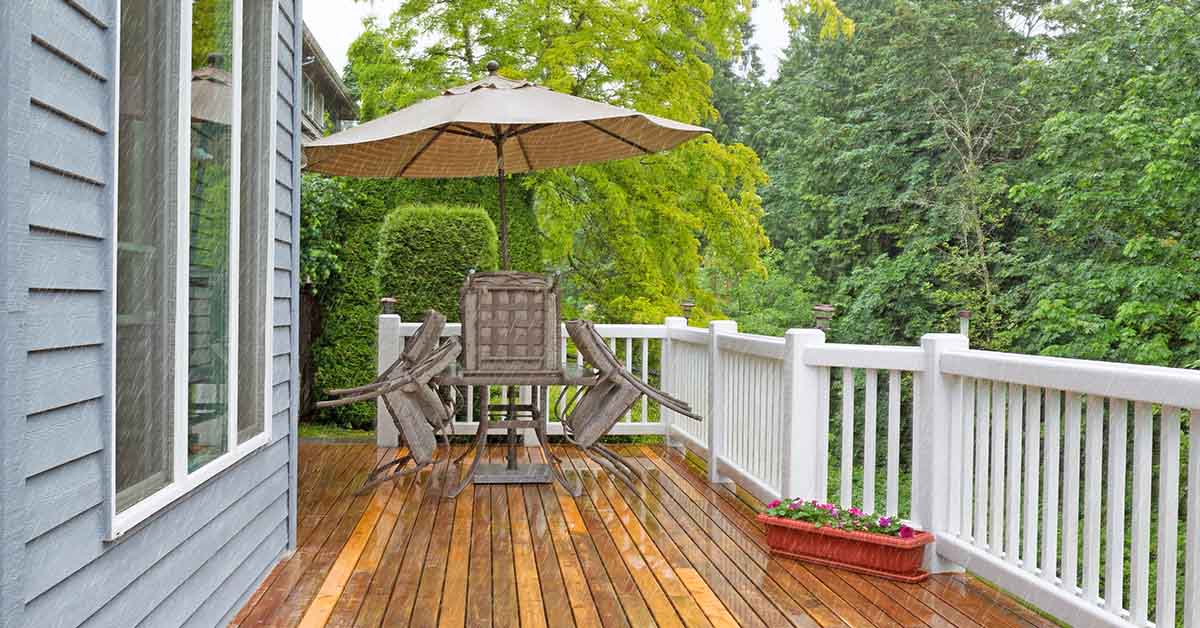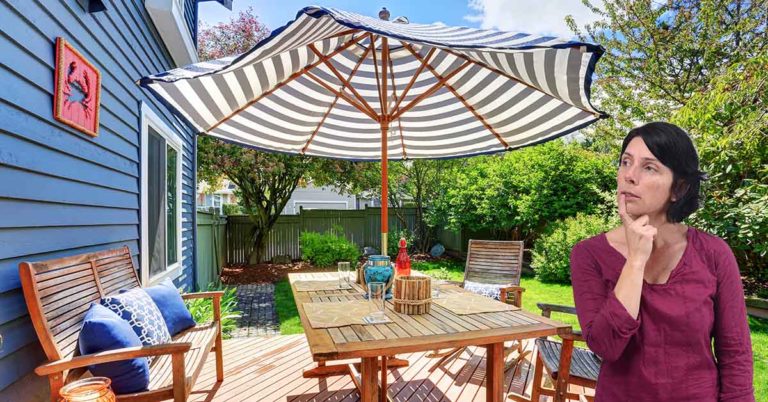How to Keep a Patio Umbrella From Falling Over: 8 Simple Tips
Sitting outside on a warm sunny day under a patio umbrella is always pleasant. Except – it’s not pleasant if you have to worry about it falling over.
The last thing you want is a patio umbrella that blows over and gets damaged.
A broken garden umbrella can be a hassle. We have another article talking about DIY fixes for your patio umbrella.
But how to keep your patio umbrella from falling over?
This article will cover all the steps you need to keep your patio umbrella safe. You can stop worrying and start relaxing outside.
1. Add More Weight to the Existing Base
The base is the most critical puzzle piece when deciding how to prevent a patio umbrella from falling over.
Making the base heavier provides reinforcement and makes the entire structure more robust.
Try adding weight bags, gravel, sandbags, or anything super heavy.
A simple solution is to add more weight is Gravipod. Essentially, it is a heavy bag that you place on a stand and fill with sand. They bags for round and rectangular bases.

2. Get a Sturdier and Larger Base
Without a suitable base, no umbrella can stay up. You’ll need a base that is large and heavy, so it can withstand the elements a whole lot better.
An umbrella that stands alone needs much more weight than one that is placed through a table.

As a general rule, the larger the canopy, the heavier your stand needs to be.
Recommended weights for the umbrella base. Please note that these are just general guidelines. Manufacturers have their own recommendations.
| Table umbrella size | Weight of the base |
|---|---|
| 6 ft or less | 20 lbs |
| up to 6.5 ft | 30 lbs |
| up to 7.5 ft | 40 lbs |
| up to 9 ft | 50 lbs |
| up to 11 ft | 70 lbs |
| Free-standing umbrella size | Weight of the base |
|---|---|
| up to 6.5 ft | 30 lbs |
| up to 7.5 ft | 40 lbs |
| up to 9 ft | 70 lbs |
| up to 11 ft | 75 lbs |
It is recommended to use the largest stand possible to prevent tipping.
The umbrella stand should have a bolt and a knob that allows you to tighten up the pole securely.

The tighter and more secure you can make the pole, the less likely that umbrella will fall over whenever inclement weather arrives.
3. Attach the Base Into the Ground
You can secure the base by drilling it into the ground or patio. So the first thing to do is make sure the umbrella is placed where you want it to be secured.
Suppose your umbrella is on a wood or composite deck. In that case, you may have another attachment option depending on the spacing between the boards.
If your base allows you to attach a strap, the strap can be passed underneath the boards.
The deck should be in good condition and strong enough to withstand the force of the wind pushing against the umbrella in this scenario.
Try wrapping the strap around multiple boards. A strap wrapped around just one deck board might cause the board to pull up in high winds instead of holding your umbrella base down.
This is also an advantage if you don’t want to purchase a new umbrella base.
4. Make Sure You Have a Supportive Patio Table
The patio table offers support to your umbrella. But the table needs to be very sturdy if you want to keep the umbrella in place.
The umbrella pole should fit snugly to the table’s hole. You can fix the gaps in the hole with an umbrella cone wedge or a new table ring. They are also helpful when you trying to prevent the umbrella from spinning.
The majority of outdoor patio tables have a hole around 2 inches. The poles are typically about 1,5 inches, but both can vary.
The patio umbrella table from Iwicker pictured below acts as a stand. It’s pretty light, but there is plenty of room to put heavy items in the basket area, like sandbags or bricks.

The bottom of the pole fits inside the table. You need to figure out how to weigh the table.
The design would be better if the umbrella’s pole slid through the entire table to the ground. Then you could use a metal base with the table for extra safety for windy conditions.
5. Always Close the Umbrella When You’re Not Using it
If you keep the umbrella closed when you’re not using it, it is much less likely to fall over whenever the weather is bad. This is a good practice even if you live in an area that isn’t very windy.
Most patio umbrellas come with a strap that has hook-and-loop fasteners on it so that it stays closed.

When your patio umbrella is tilted and open, it is simply easier for it to fall over and even fly away into the wind when you least expect it.
Keeping the umbrella closed and secured reduces the chances of this happening during windy weather.
6. Be Proactive When It Comes to Strong Winds
If you live in an area that experiences windy weather regularly, being proactive is a brilliant thing to do. Occasionally, you can take a few precautions and still experience your patio umbrella falling over. Still, there are a few things you can do about it.
Size of the umbrella – Consider the size of the umbrella when selecting one for your patio. The larger the umbrella, the higher the chance that it will simply be blown away by the wind. However, it should be spacious enough so that you and your friends or family can sit under it.
Location – Choose the right area to protect from wind. That means a location close to a building structure or even a fence. This way, at least some of those winds will be blocked.
Take shelter – Additionally, you can close up your umbrella and bring it inside when you’re expecting a storm or windy weather.
7. Buy a Patio Umbrella That Has Air Vents
Most patio umbrellas have air vents.
Air vents perform two essential tasks: they allow the air to breeze through so that it’s not too hot under the umbrella, and the airflow helps reduce the power of wind gusts.
So a canopy with ventilation can improve wind resistance.

Although most patio umbrellas come with air vents, some do not.
If you have an umbrella made without the vents, you can either buy one with vents or take it to a tailor’s shop and get them to put vents in it. It might be less expensive and simpler just to buy another patio umbrella.
8. Avoid Plastic or Wood Frames
Wooden frames may sound sturdy, but they are not as durable as frames and ribs made out of aluminum and steel.
Wooden or plastic frames can easily break when they fall.
The Bottom Line
Patio umbrellas can be expensive, but even if you find a reasonably priced one, you don’t want it constantly falling over or flying away. It’s not just inconvenient, but other bad things can happen as well, including the umbrella becoming damaged or even injuring someone nearby.
If you’re aware that this could happen, there are many things you can do about it. It starts with taking the previous tips seriously so you can keep your patio umbrella in its proper place for a very long time.


